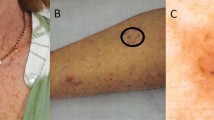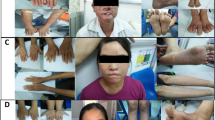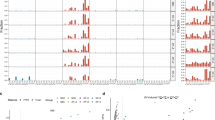Abstract
Xeroderma pigmentosum is a monogenic disease characterized by hypersensitivity to ultraviolet light. The cells of xeroderma pigmentosum patients are defective in nucleotide excision repair, limiting their capacity to eliminate ultraviolet-induced DNA damage, and resulting in a strong predisposition to develop skin cancers1. The use of rare cutting DNA endonucleases—such as homing endonucleases, also known as meganucleases—constitutes one possible strategy for repairing DNA lesions. Homing endonucleases have emerged as highly specific molecular scalpels that recognize and cleave DNA sites, promoting efficient homologous gene targeting through double-strand-break-induced homologous recombination. Here we describe two engineered heterodimeric derivatives of the homing endonuclease I-CreI, produced by a semi-rational approach. These two molecules—Amel3–Amel4 and Ini3–Ini4—cleave DNA from the human XPC gene (xeroderma pigmentosum group C), in vitro and in vivo. Crystal structures of the I-CreI variants complexed with intact and cleaved XPC target DNA suggest that the mechanism of DNA recognition and cleavage by the engineered homing endonucleases is similar to that of the wild-type I-CreI. Furthermore, these derivatives induced high levels of specific gene targeting in mammalian cells while displaying no obvious genotoxicity. Thus, homing endonucleases can be designed to recognize and cleave the DNA sequences of specific genes, opening up new possibilities for genome engineering and gene therapy in xeroderma pigmentosum patients whose illness can be treated ex vivo.
This is a preview of subscription content, access via your institution
Access options
Subscribe to this journal
Receive 51 print issues and online access
$199.00 per year
only $3.90 per issue
Buy this article
- Purchase on Springer Link
- Instant access to full article PDF
Prices may be subject to local taxes which are calculated during checkout




Similar content being viewed by others
References
Cleaver, J. E. Cancer in xeroderma pigmentosum and related disorders of DNA repair. Nature Rev. Cancer 5, 564–573 (2005)
Pabo, C. O., Peisach, E. & Grant, R. A. Design and selection of novel Cys2His2 zinc finger proteins. Annu. Rev. Biochem. 70, 313–340 (2001)
Porteus, M. H. & Baltimore, D. Chimeric nucleases stimulate gene targeting in human cells. Science 300, 763 (2003)
Urnov, F. D. et al. Highly efficient endogenous human gene correction using designed zinc-finger nucleases. Nature 435, 646–651 (2005)
Bibikova, M., Beumer, K., Trautman, J. K. & Carroll, D. Enhancing gene targeting with designed zinc finger nucleases. Science 300, 764 (2003)
Lombardo, A. et al. Gene editing in human stem cells using zinc finger nucleases and integrase-defective lentiviral vector delivery. Nature Biotechnol. 25, 1298–1306 (2007)
Bibikova, M., Golic, M., Golic, K. G. & Carroll, D. Targeted chromosomal cleavage and mutagenesis in Drosophila using zinc-finger nucleases. Genetics 161, 1169–1175 (2002)
Szczepek, M. et al. Structure-based redesign of the dimerization interface reduces the toxicity of zinc-finger nucleases. Nature Biotechnol. 25, 786–793 (2007)
Miller, J. C. et al. An improved zinc-finger nuclease architecture for highly specific genome editing. Nature Biotechnol. 25, 778–785 (2007)
Jacquier, A. & Dujon, B. An intron-encoded protein is active in a gene conversion process that spreads an intron into a mitochondrial gene. Cell 41, 383–394 (1985)
Chevalier, B. S. & Stoddard, B. L. Homing endonucleases: structural and functional insight into the catalysts of intron/intein mobility. Nucleic Acids Res. 29, 3757–3774 (2001)
Wang, J., Kim, H. H., Yuan, X. & Herrin, D. L. Purification, biochemical characterization and protein–DNA interactions of the I-CreI endonuclease produced in Escherichia coli . Nucleic Acids Res. 25, 3767–3776 (1997)
Jurica, M. S., Monnat, R. J. & Stoddard, B. L. DNA recognition and cleavage by the LAGLIDADG homing endonuclease I-CreI. Mol. Cell 2, 469–476 (1998)
Arnould, S. et al. Engineering of large numbers of highly specific homing endonucleases that induce recombination on novel DNA targets. J. Mol. Biol. 355, 443–458 (2006)
Smith, J. et al. A combinatorial approach to create artificial homing endonucleases cleaving chosen sequences. Nucleic Acids Res. 34, e149 (2006)
Arnould, S. et al. Engineered I-CreI derivatives cleaving sequences from the human XPC gene can induce highly efficient gene correction in mammalian cells. J. Mol. Biol. 371, 49–65 (2007)
Silva, G. H. & Belfort, M. Analysis of the LAGLIDADG interface of the monomeric homing endonuclease I-DmoI. Nucleic Acids Res. 32, 3156–3168 (2004)
Schymkowitz, J. et al. The FoldX web server: an online force field. Nucleic Acids Res. 33, W382–W388 (2005)
Soutoglou, E. et al. Positional stability of single double-strand breaks in mammalian cells. Nature Cell Biol. 9, 675–682 (2007)
Saintigny, Y., Delacote, F., Boucher, D., Averbeck, D. & Lopez, B. S. XRCC4 in G1 suppresses homologous recombination in S/G2, in G1 checkpoint-defective cells. Oncogene 26, 2769–2780 (2007)
Rimseliene, R., Maneliene, Z., Lubys, A. & Janulaitis, A. Engineering of restriction endonucleases: using methylation activity of the bifunctional endonuclease Eco57I to select the mutant with a novel sequence specificity. J. Mol. Biol. 327, 383–391 (2003)
Samuelson, J. C. & Xu, S. Y. Directed evolution of restriction endonuclease BstYI to achieve increased substrate specificity. J. Mol. Biol. 319, 673–683 (2002)
Buchholz, F. & Stewart, A. F. Alteration of Cre recombinase site specificity by substrate-linked protein evolution. Nature Biotechnol. 19, 1047–1052 (2001)
Santoro, S. W. & Schultz, P. G. Directed evolution of the site specificity of Cre recombinase. Proc. Natl Acad. Sci. USA 99, 4185–4190 (2002)
Voziyanov, Y., Konieczka, J. H., Stewart, A. F. & Jayaram, M. Stepwise manipulation of DNA specificity in Flp recombinase: progressively adapting Flp to individual and combinatorial mutations in its target site. J. Mol. Biol. 326, 65–76 (2003)
Jamieson, A. C., Miller, J. C. & Pabo, C. O. Drug discovery with engineered zinc-finger proteins. Nature Rev. Drug Discov. 2, 361–368 (2003)
Ashworth, J. et al. Computational redesign of endonuclease DNA binding and cleavage specificity. Nature 441, 656–659 (2006)
Bernerd, F. et al. Clues to epidermal cancer proneness revealed by reconstruction of DNA repair-deficient xeroderma pigmentosum skin in vitro . Proc. Natl Acad. Sci. USA 98, 7817–7822 (2001)
Prieto, J. et al. The C-terminal loop of the homing endonuclease I-CreI is essential for site recognition, DNA binding and cleavage. Nucleic Acids Res. 35, 3262–3271 (2007)
Zhang, Z. & Marshall, A. G. A universal algorithm for fast and automated charge state deconvolution of electrospray mass-to-charge ratio spectra. J. Am. Soc. Mass Spectrom. 9, 225–233 (1998)
Krissinel, E. & Henrick, K. Inference of macromolecular assemblies from crystalline state. J. Mol. Biol. 372, 774–797 (2007)
Luscombe, N. M., Laskowski, R. A. & Thornton, J. M. NUCPLOT: a program to generate schematic diagrams of protein–nucleic acid interactions. Nucleic Acids Res. 25, 4940–4945 (1997)
Delacote, F., Han, M., Stamato, T. D., Jasin, M. & Lopez, B. S. An xrcc4 defect or Wortmannin stimulates homologous recombination specifically induced by double-strand breaks in mammalian cells. Nucleic Acids Res. 30, 3454–3463 (2002)
Acknowledgements
We would like to thank J. Casado and D. Megias for technical support and the beamline staff at the ESRF and SLS for advice during data collection. This project received financial support from the EU MEGATOOL project (LSHG-CT-2006-037226). A.A. is partly funded by a CRG-Novartis fellowship.
Author information
Authors and Affiliations
Corresponding authors
Supplementary information
Supplementary Information
This file contains a Supplementary Discussion, Supplementary References, Supplementary Tables I-V and Supplementary Figures 1-8 with Legends. (PDF 13943 kb)
Rights and permissions
About this article
Cite this article
Redondo, P., Prieto, J., Muñoz, I. et al. Molecular basis of xeroderma pigmentosum group C DNA recognition by engineered meganucleases. Nature 456, 107–111 (2008). https://doi.org/10.1038/nature07343
Received:
Accepted:
Issue Date:
DOI: https://doi.org/10.1038/nature07343
This article is cited by
-
Meganuclease targeting of PCSK9 in macaque liver leads to stable reduction in serum cholesterol
Nature Biotechnology (2018)
-
Understanding the indirect DNA read-out specificity of I-CreI Meganuclease
Scientific Reports (2018)
-
Signal-on electrochemical assay for label-free detection of TdT and BamHI activity based on grown DNA nanowire-templated copper nanoclusters
Analytical and Bioanalytical Chemistry (2017)
-
Genome-editing Technologies for Gene and Cell Therapy
Molecular Therapy (2016)
-
Visualizing phosphodiester-bond hydrolysis by an endonuclease
Nature Structural & Molecular Biology (2015)
Comments
By submitting a comment you agree to abide by our Terms and Community Guidelines. If you find something abusive or that does not comply with our terms or guidelines please flag it as inappropriate.



